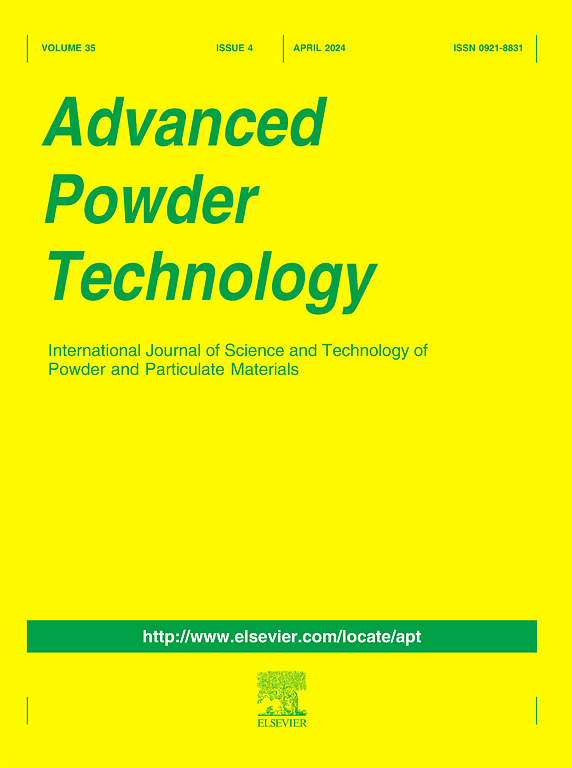Construction of novel double S-scheme TiO2-x/BiOCl/BiCl3Br-CTA nanocomposites with quantum dot size for the photocatalytic degradation of pollutants
IF 4.2
2区 工程技术
Q2 ENGINEERING, CHEMICAL
引用次数: 0
Abstract
In this study, TiO2-x/BiOCl/BiCl3Br-CTA (TOVBBOC) nanocomposites, in which CTA denotes cetyltrimethylammonium cation, were fabricated through a facile hydrothermal method. The nanocomposites were investigated for photocatalytic degradation of azithromycin (Azi), tetracycline (TC), methyl orange (MO), fuchsine (FS), and rhodamine B (RhB) upon visible light. The photocatalytic efficiencies of TOVBBOC-2 were 37.2, 15.3, 20.2, 13.8, and 5.59 times higher than TiO2-x (TOV) and 18.1, 22.1, 16.6, 20.3, and 14.2 folds larger than BiOCl/BiCl3Br-CTA for the degradations of Azi, TC, MO, FS, and RhB, respectively. Furthermore, the cycling tests confirmed that the TOVBBOC-2 nanocomposite displayed a high photostability. The significant photocatalytic performance of TOVBBOC-2 heterojunction was mainly attributed to the increased visible-light absorption and a lower recombination rate of photogenerated charges. A photo-removal mechanism on the TOVBBOC-2 photocatalyst was also proposed based on band position and radical trapping tests. Importantly, the biocompatibility of the TC solution after treating over the TOVBBOC-2 nanocomposite was studied via the growth of wheat seeds. The current research offered a promising route for fabricating an effective visible-light-driven material for environmental remediation.

新型双S-scheme TiO2-x/BiOCl/BiCl3Br-CTA量子点纳米复合材料光催化降解污染物的构建
本研究采用水热法制备了以十六烷基三甲基铵阳离子为CTA的TiO2-x/BiOCl/BiCl3Br-CTA (TOVBBOC)纳米复合材料。研究了纳米复合材料在可见光下光催化降解阿奇霉素(Azi)、四环素(TC)、甲基橙(MO)、品红(FS)和罗丹明B (RhB)的性能。TOVBBOC-2的光催化效率分别是TiO2-x (TOV)的37.2、15.3、20.2、13.8和5.59倍,是BiOCl/BiCl3Br-CTA的18.1、22.1、16.6、20.3和14.2倍。此外,循环试验证实了TOVBBOC-2纳米复合材料具有较高的光稳定性。TOVBBOC-2异质结具有显著的光催化性能,主要是由于其增加了可见光吸收和光生电荷的复合率较低。基于能带位置和自由基捕获试验,提出了TOVBBOC-2光催化剂的光去除机理。重要的是,通过小麦种子的生长研究了TOVBBOC-2纳米复合材料处理后的TC溶液的生物相容性。目前的研究为制造一种有效的用于环境修复的可见光驱动材料提供了一条有希望的途径。
本文章由计算机程序翻译,如有差异,请以英文原文为准。
求助全文
约1分钟内获得全文
求助全文
来源期刊

Advanced Powder Technology
工程技术-工程:化工
CiteScore
9.50
自引率
7.70%
发文量
424
审稿时长
55 days
期刊介绍:
The aim of Advanced Powder Technology is to meet the demand for an international journal that integrates all aspects of science and technology research on powder and particulate materials. The journal fulfills this purpose by publishing original research papers, rapid communications, reviews, and translated articles by prominent researchers worldwide.
The editorial work of Advanced Powder Technology, which was founded as the International Journal of the Society of Powder Technology, Japan, is now shared by distinguished board members, who operate in a unique framework designed to respond to the increasing global demand for articles on not only powder and particles, but also on various materials produced from them.
Advanced Powder Technology covers various areas, but a discussion of powder and particles is required in articles. Topics include: Production of powder and particulate materials in gases and liquids(nanoparticles, fine ceramics, pharmaceuticals, novel functional materials, etc.); Aerosol and colloidal processing; Powder and particle characterization; Dynamics and phenomena; Calculation and simulation (CFD, DEM, Monte Carlo method, population balance, etc.); Measurement and control of powder processes; Particle modification; Comminution; Powder handling and operations (storage, transport, granulation, separation, fluidization, etc.)
 求助内容:
求助内容: 应助结果提醒方式:
应助结果提醒方式:


